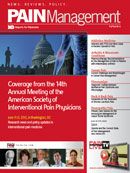Publication
Article
Pain Management
NCCN: Current Challenges and Breakthoughs in Cancer Pain Management
Author(s):
Cancer pain management has improved over the last decade with advances in oral and intravenous medication; however, several challenges still exist in administration.
Judith A. Paice, PhD, RN, FAAN, a researchprofessor in medicine-hematology/oncologyat the Robert H. Lurie ComprehensiveCancer Center of Northwestern Universityin Chicago, discussed the challenges associatedwith managing cancer pain and providedstrategies to improve pain management in apresentation during the 2012 National ComprehensiveCancer Network (NCCN) Nursingprogram at the NCCN 2012 17th AnnualConference, held in Hollywood, Florida.
According to the National ComprehensiveCancer Network’s guidelines for assessmentof pain in adult cancer patients (http://bit.ly/LS9SkK), pain should be assessed for location,duration, intensity, quality (nociceptive,neuropathic or visceral), timing, and aggravatingor alleviating factors. In addition, cancerpatients with pain should be assessed for othersymptoms, current therapies, prior treatmentresponse, function changes, family history ofsubstance abuse, and risk factors for aberrantuse or diversion.
The quality of the pain, whether nociceptive,neuropathic, or visceral, is important fordetermining which pharmacologic interventionwould be most effective. While nonsteroidalanti-inflammatory drugs (NSAIDs)are effective for nociceptive pain, these agentsare not helpful for neuropathic pain.
According to Paice, the key challenges inthe management of cancer pain include balancinganalgesia versus safety and ensuringmedication access versus preventing diversion.Finding the appropriate mix of safety vs.analgesia does not always necessarily dependonly on the specific drug prescribed to thepatient. For example, while acetaminophen isa very commonly used analgesic for the managementof cancer pain, it can be quite dangerousif patients exceed the maximum dailyrecommended dose, which frequently happens because many patients are not aware thatmany pain (and cold and allergy) productsthey may be taking also include the drug. Asa result, acetaminophen overdose is the leadingcause of acute liver failure in the UnitedStates. On January 13, 2011, the Food and DrugAdministration asked manufacturers to limitacetaminophen to 325 mg per tablet or dosingunit and to add a box warning regarding therisk of liver toxicity (http://1.usa.gov/JzIisp).
Another major challenge in prescribing painmedication is preventing misuse, abuse, anddiversion. Sources of diversion include theftsfrom pharmacies, drug distribution centers,and medicine cabinets. Easier access to prescriptionpain medications afforded by Internetpharmacies, smuggling, and prescriptions from“pill mills†have also contributed to an increasein the use of these medications for non-medicalpurposes. In an effort to prevent diversion,Paice recommended educating patients andfamilies regarding safe medication practicesand safe disposal of pain medications. “Thegoals of treatment include prevention, relief ofpain, improved function, safety, and preventdiversion,†Paice said. Currently available treatmentoptions for pain management includenon-opioids (acetaminophen or NSAIDs),opioids, adjuvants, and anticancer therapies.
Paice reminded that opioids are fundamentalto good cancer pain management andare available in a variety of forms includingtablets, sublingual tablets, buccal solublefilm, and nasal spray. Typically, these agentsrequire prior authorization or partial fills andare associated with a variety of side effectsthat range from respiratory depression andsedation to nausea and vomiting.Adjuvant options for cancer pain managementinclude corticosteroids, anti-epilepsydrugs, anti-depressants, local anesthetics,NMDA receptor antagonists, and cannabinoids. Corticosteroids can be administeredorally, intravenously or epidurally and havebeen shown to be effective in reducing pain.However, Paice warned that corticosteroidsmay produce pyschosis and long-term usemay lead to proximal muscle wasting.
Of the anti-epilepsy drugs used to managesome cancer pain, gabapentin is generallywell-tolerated and is often used for breakthroughpain or the treatment of neuropathicpain. However, older formulations of the drugare administered three times per day and maybe associated with dizziness and sedation. Anewer, once-daily formulation was approvedlast year (though not specifically for the managementof cancer pain) that has been associatedwith improved treatment adherence andfewer side effects. Pregabalin is another antiepilepsydrug that has been associated withimproved bioavailablity at high doses.
Anti-depressants such as tricyclic anti-depressants(including nortriptyline and desipramine)and serotonin–norepinephrine reuptake inhibitors(including vanlafaxine and duloxetine) havebeen effective in providing good pain control,with limited adverse events. Topical anestheticssuch as lidocaine patches or creams have beeneffective in treating localized pain.
Due to the legal and regulatory challengesassociated with the use of medical marijuana,manufacturers are looking into syntheticcompounds that target CB1 and CB2 receptors,as these agents provide good paincontrol without the feeling of euphoriaassociated with medical marijuana.
Overall, according to Paice, there are avariety of effective agents available for thetreatment of pain associated with cancer;however, practitioners need to be aware ofthe risk of adverse events, drug-drug interactions,and diversion, taking necessary precautionsto prevent these occurrences.
